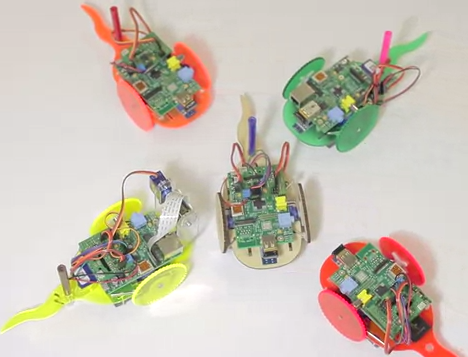Tiddlybot robot encourages higher order thinking skills for kids

Developed to help young people learn about robotics and programming, the Tiddlybot was recently launched on Kickstarter. The TiddlyBot is based on the low cost Raspberry Pi mini-computer and allows users to turn a Raspberry Pi into a robot.

The TiddlyBot can draw pre-programmed or freestyle. It can follow lines, output a live wireless video feed and be controlled from a web interface from a smart phone, tablet or any other PC with a browser.
It is intended to make the next generation of technology learning simple and fun, according to its creators.
The robot combines electronics, technology, construction, software development and creative skills. Both children and adults will find it really easy to use and engage with.
Currently Blockly and Python are the main languages supported although there is a less developed API in Javascript available.
The TiddlyBot encourages development of such skills as problem solving, programming and the basics of robotics. It does the simple things really well, helping people learn coding.
TiddlyBot can be trained to be autonomous, following lines accurately — a great way to explain robotics to young people.
The San Francisco-based start-up also has offices in Bristol, UK. For the past two years the team of designers, engineers and coders has been running workshops for young people to help teach them about technology.
Although the Raspberry Pi has incredible potential, it needs “great content and applications to excite and engage the next generation” according to the team.
"TiddlyBot is fantastic at focusing all types of learners."~ Agilic CEO, Harry Gee
"Tiddles," as the company affectionately refers to the robot, comes in a range of colours as well as a wood version that is made from sustainable plywood.
It can be built with a 1080p HD camera, which is included in the ultra kit. The board has RGB LEDs, support for four servos, as well as the line-following module.
The board has full pass-through of the GPIO as well as spare powered IO to add additional hardware.
The interface board features efficient power conversion to keep your batteries going longer. There is also an option for onboard battery charging for minimizing fuss.
The team (made up of students spanning two continents) wanted to create a low-cost and effective way to teach robotics to children and get them up and running, according to Patrick Brinston, Robotics Engineer at Agilic.
The team wanted to create a design that would make the TiddlyBot as simple as possible to develop. This is reflected in the minimalistic hardware and software design.
Agilic CEO, Harry Gee said:
"We've been working hard to create something to engage and empower the next generation of engineers, programmers and scientists and we think TiddlyBot is fantastic at focusing all types of learners."
Children find it easy to use and fun to play with. The driving force behind its creation is to empower future generations with some of the fundamentals of programming. It also supports the learning of Python and Javascript for more advanced students.
Both hardware and software used for the project were designed to be simple and straightforward to use. It enables learners to build confidence with robotics and engineering principles.
With starting pledges to attend a robot-making workshop starting at just $15, the TiddlyBot offers a cost-effective way to develop young people's minds in a wide range of areas.
It costs $48 to purchase the TiddlyBot kit which includes the interface board, SD Card, illustrated instructions and a learner guide. Pledgers are asked for $37 to own the interface.
Its Kickstarter campaign has already reached its initial goal of $27,000, and is now moving forward to its stretch goals: $35,000 will allow the team to produce the illustrated beginners guide to robotics, while $50,000 will bring interactive fun and games to the TiddlyBot. The campaign closes on July 26th 2014.
The campaign seeks to fund research into the many ways the TiddlyBot, and other Raspberry Pi bots, can be adapted and applied to enhance the learning of Science, Technology, Engineering and Maths (STEM).
This is a great project and deserves backing, not only from individuals but also from schools. Getting your kids interested in technology from an early age is a sure way to make sure that they succeed when they reach the overcrowded job market.
And Tiddles might just be the robot that sparks a lifelong interest in cool and geeky technology.
Related articles: